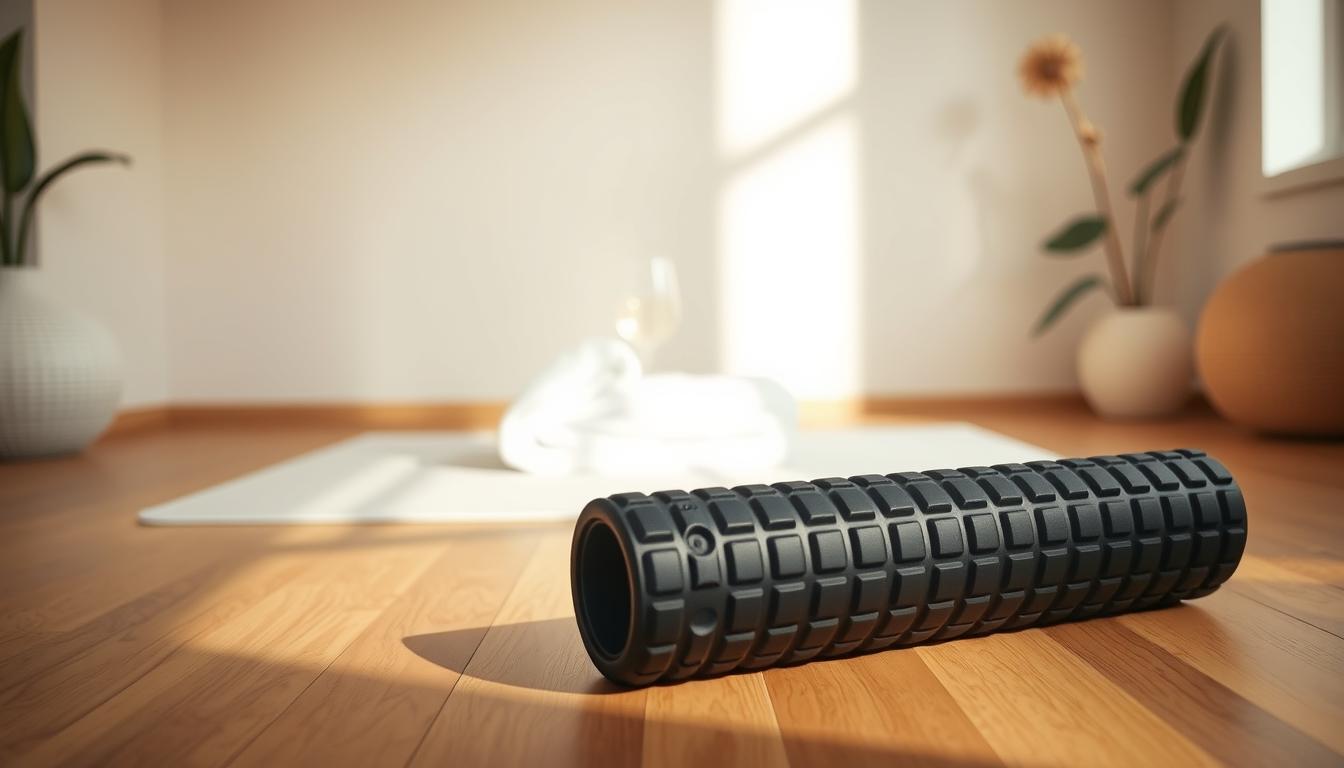In today’s world, many of us are feeling neck pain. It’s mainly because we use laptops and smartphones a lot. This kind of pain can make it hard to do our daily tasks and enjoy life.
But there’s good news. You can relieve neck pain by following some simple ergonomic advice and doing certain exercises. It’s very important to know how to set up your laptop correctly and learn how to manage pain. We’re going to share some great tips and exercises that can help. They will make you feel more comfortable every day.
Understanding Neck Pain in the Digital Age
Neck pain is now common in the digital era, mainly because of sitting too much. Many people spend hours each day using gadgets. This often leads to pain and ongoing neck issues.
This problem, called tech neck, happens when you look down at screens for too long. It strains your neck and muscles around it.
With our lives wrapped around technology, knowing how it affects neck pain is key. Bad posture and not moving much make tech neck worse. To fight this, people should take regular breaks and use good ergonomics. This lowers the chance of getting serious neck pain.
What Are the Common Causes of Neck Pain?
Knowing why neck pain happens is key to taking care of it. Poor posture is a big cause, especially for people who sit a lot at work. When we slouch or lean too much, it can stress our neck muscles and harm our spine.
In a lot of offices, the setup isn’t great for our necks. If your chair or desk is too high or low, or if your computer screen isn’t placed right, it can make neck pain worse. Fixing these ergonomic problems can really help ease neck strain.
Our lifestyle choices can also lead to neck pain. Not drinking enough water can make the discs in our neck less flexible, which might lead to pain. Smoking also hurts our neck by damaging our spine’s health. Making better lifestyle choices can greatly improve neck health and comfort.
Ergonomic Workstations for Neck Pain Prevention
It’s important to have an ergonomic workstation to avoid neck pain. This is vital because a lot of us spend many hours in front of computers every day. To improve comfort and reduce strain, it’s essential to adjust your desk height, pick the right chair, and set your monitor height correctly. Here are some important parts to think about for your setup.
Adjust Your Desk Height for Optimal Comfort
Getting your desk height right is key for a pain-free workspace. When your desk is at the right height, your forearms will be parallel to the ground as you type. This helps prevent strain on your neck and shoulders. Make sure your elbows are at a 90-degree angle to keep your posture comfy all day.
Choose the Right Chair for Proper Support
Choosing the right chair is crucial for feeling good while you work. A good chair supports your lower back and aligns with your spine. Your feet should be flat on the floor, or use a footrest to avoid leg and hip tension. This also helps keep your neck properly aligned.
Elevate Your Monitor for Eye Level Viewing
Setting your monitor at the right height helps avoid neck pain. The top should be at or just below eye level so you look slightly down. This position keeps your head neutral, preventing you from leaning forward or twisting your neck. This way, you’re more comfortable while working.
Postural Changes to Alleviate Neck Discomfort
Making the right changes in how we sit or stand is crucial for easing neck pain. In today’s world, where many of us lean our heads forward while using gadgets, stress on the neck muscles and joints increases. By making a few important adjustments, we can feel more comfortable and reduce this discomfort.
Correcting Forward Head Posture
When our heads jut forward, our body alignment is off. It’s important to remember to check where our head is throughout the day. Try to gently move your neck back and line your ears up with your shoulders. Being aware of your posture all day can help fix this widespread problem.
Engaging Your Core for Better Spine Alignment
Using your core muscles is key for keeping your spine aligned. When these muscles are engaged, they support the spine and lessen neck strain. Adding exercises like planks or abdominal holds to your daily activities can boost posture and stability, whether you’re sitting or standing.
Keeping Shoulders Relaxed and Away from Ears
Relaxing your shoulders can help lower neck tension. Make sure your shoulders aren’t tight or lifted up toward your ears when you’re at work or relaxing. Check on your posture often and let your shoulders drop naturally. This easy change can improve blood flow and make your neck feel better.
Exercises to Reduce Neck Pain From Laptop Use
Doing special exercises for the neck can really help lessen the pain that comes from using a laptop too much. These moves include stretches and exercises to make your neck muscles stronger, helping your neck be more flexible and stable. Adding movement breaks throughout your day stops muscles from getting too tense and keeps you feeling good.
Neck Stretches for Flexibility
Stretching your neck makes it more flexible and less stiff. Try these helpful stretches:
- Chin Tuck: Sit or stand straight and pull your chin down to your chest for a few seconds.
- Side Neck Stretch: Bend your head to one side until your ear is close to your shoulder, then switch sides.
- Neck Rotation: Gently turn your head to one side and hold it there. Then do the other side for full movement.
Strengthening Exercises for Neck and Shoulders
Strong neck and shoulder muscles support you better and keep pain away. Add these exercises to get stronger:
- Shoulder Blade Squeeze: Sit up tall and press your shoulder blades together, hold it for a bit.
- Neck Isometrics: Push your forehead into your hands without moving your head, to work the neck muscles.
- Wall Angels: Stand against a wall and move your arms in a “W” to “Y” shape, touching the wall.
Integrating Movement Breaks During Work Hours
Moving around during your workday is key to avoid neck pain from laptop use. Plan to stretch or move every 30 to 60 minutes. Here are some tips:
- Use a timer to remind yourself to stand up and move.
- Do some easy stretches or walk a little in your work area.
- Use your breaks to drink water and fix your sitting posture.
Managing Tech Neck with Smart Device Use
As we use technology more, the issue of tech neck grows. To handle tech neck well, we must look at how we hold our devices. Keeping smartphones or tablets at eye level can really help ease neck pain. Making sure our devices are at the right height can improve our posture and make us feel better.
Adjusting Device Heights for Ergonomics
Putting screens in the right place is key to avoiding the bad side effects of using smartphones too much. Here are a few easy rules to follow for better device ergonomics:
- Maintain eye level alignment by using stands or holders.
- Keep your elbows at a comfortable angle while typing or swiping.
- Utilize alternative input devices, such as Bluetooth keyboards, for better posture.
Taking Scheduled Breaks to Prevent Strain
Using our devices non-stop can make us tired and sore. But, taking planned breaks can help reduce that. The 20-20-20 rule works well: every 20 minutes, pause for 20 seconds to look at something 20 feet away. Adding these breaks into our routine can help lower the risks from too much smartphone use.
The Importance of Regular Exercise for Neck Health
Regular exercise is key to keeping your neck healthy. It strengthens and makes muscles flexible that hold up your neck. By staying active, you can also handle neck pain better and prevent injuries. Injuries can happen due to bad posture or tense muscles.
Benefits of Overall Fitness on Neck Pain
Being fit helps a lot with neck pain. When you exercise, your blood flow gets better. And your body makes endorphins. These are like nature’s painkillers. They lessen pain and make it easier to deal with discomfort. This makes your body stronger against pain.
Activities that Support Neck and Upper Back Strength
Some activities are really good for your neck and upper back. These include:
- Resistance training that focuses on your shoulders and neck.
- Yoga, which is great for flexibility and balance.
- Upper body exercises that work on muscle tone, stability, and how well you stand.
Adding these exercises to your routine is a big plus. They boost your upper back’s strength. Strong muscles mean less tension around the neck. This can improve how you stand and lessen pain. Regular workouts are a must for a healthy neck and a happy life.
Best Practices for Sleeping to Prevent Neck Pain
Effective sleeping habits are key to avoiding neck pain. A good sleep position and the right pillow are crucial. They help keep your neck supported all night. Let’s look at the best ways to sleep well and avoid neck pain.
Choosing the Right Pillow
A good pillow is crucial for a restful sleep and keeping your spine straight. Memory foam pillows work well because they support your head and neck right. Here’s how to pick a pillow:
- Select a pillow height that fits how you sleep; side sleepers need a thicker, firmer pillow, while back sleepers should go for a flatter one.
- Your pillow should let your neck line up with your spine, avoiding strain.
- Think about getting an adjustable pillow for personalized comfort.
Ideal Sleep Positions for Neck Relief
How you sleep affects your neck pain. Here are the best positions for sleep:
- Back sleepers should use a supportive pillow to keep the spine neutral.
- If you sleep on your side, a pillow between your neck and shoulder helps keep your spine straight.
- Try to avoid sleeping on your stomach as it twists your neck, causing more pain.

Hydration and Lifestyle Choices for Neck Health
Staying hydrated is vital for keeping the cervical discs in your neck healthy. These discs are mostly water. If you don’t drink enough water, these discs might start to break down. This can cause neck pain and discomfort. Making good choices in your life can help keep your neck healthy. Drinking enough water helps keep your cervical discs strong and boosts your overall health.
Healthy habits can make your neck stronger. Regular exercise increases blood flow to your neck and makes the muscles supporting your spine stronger. Staying away from smoking also lowers your risk of neck problems.
- Drink plenty of water throughout the day to maintain optimal hydration levels.
- Incorporate stretching and strengthening exercises into your routine.
- Maintain a healthy diet rich in anti-inflammatory foods.
Consulting a Professional for Neck Pain Management
Getting professional help for neck pain is key to feeling better and staying healthy. Specialists like physical therapists have the skills to check your condition and make a plan just for you. This plan might have special exercises, hands-on treatment, and changes in how you live to help reduce your pain.
Finding out why you have neck pain is very important. A healthcare provider can look closely to see if it’s because of bad posture, muscle strain, or other health issues. Knowing the cause helps them pick the best way to manage your neck pain, which can make you feel much better.
Physical therapy can bring great results, like making your neck more flexible and strong, and improving how it moves. Therapists also teach you exercises that fit your needs. This helps you get better and keeps your neck healthy.
Creating a Personalized Neck Pain Relief Plan
Creating your own plan for neck pain relief starts with understanding your unique symptoms. Including special exercises is key to targeting these issues. It also helps to add strategies you manage on your own to boost your plan’s success.
A good neck pain relief plan has ergonomic adjustments, specific exercises, and life changes. Ergonomics make your work area easy on your neck. This includes setting up your desk right and picking the best chair. Doing the right exercises for neck strength and flexibility regularly helps a lot.
Adding self-care steps to your everyday life lets you control your neck health. Small things like fixing how you sit, stretching often, and careful movements make a big difference. It’s important to keep checking and changing your plan as you get better.
Conclusion
To fight neck pain from using a laptop too much, we need a good plan. This plan should mix ergonomic fixes, right exercises, and smart lifestyle choices. Trying out the neck pain solutions we talked about can ease your pain and help you build better habits.
Make your workspace better with the right setup. Do special exercises for your neck and upper back. Remember to keep a good posture all day. These steps will not only lessen your pain but also boost your overall health. You’ll feel better and stay active in your day-to-day life.
It’s important to take care of your neck health early on. Put these tips into action to make your life better. This will help you stay physically and mentally strong.



